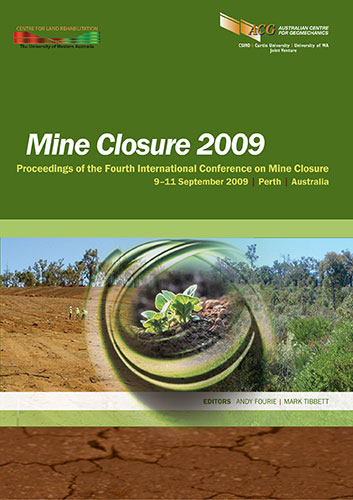Environmental envelopes — identifying limits affecting ecosystem management after mining

|
Authors: Fey, MV; Mills, AJ |
DOI https://doi.org/10.36487/ACG_repo/908_Fey
Cite As:
Fey, MV & Mills, AJ 2009, 'Environmental envelopes — identifying limits affecting ecosystem management after mining', in AB Fourie & M Tibbett (eds), Mine Closure 2009: Proceedings of the Fourth International Conference on Mine Closure, Australian Centre for Geomechanics, Perth, pp. 33-40, https://doi.org/10.36487/ACG_repo/908_Fey
Abstract:
Environmental envelopes are so named because they depict how parameters of interest are shaped by their environment. They are boundary lines separating the observed world from an imaginary one. Quantile regression enables us to determine their position objectively. Once located, the envelope enables us to separate the range(s) of a determinant variable over which some variable of interest (relating to biological performance, for example) is inevitably minimal from the range over which it is potentially at its maximum value. Thus, in ecosystem management, which is critical to the sustainability of land use after mine closure, we can identify ways in which plant cover and species diversity are affected by environmental variables such as soil infiltrability even under conditions when other determinants are not kept constant. Recognising this paradigm allows restoration ecologists to reduce their dependence on factorial field experiments for discovering suitable methods of mine site rehabilitation. It is also applicable to discovering relationships between abiotic variables in large data sets, such as that between routinely measured soil properties and ones which are not readily determined but of which knowledge is critical in determining appropriate restoration practices after mining. If combined with the diagnosis and recommendation integrated system (DRIS) principles and enough spade work to build a reliable and comprehensive database, it could revolutionise management by generating norms in terms of which the factors affecting ecosystem function can be ranked in order of limiting importance.
References:
Beaufils, E.R. (1973) Diagnosis and recommendation integrated system (DRIS), Soil Science Bulletin, No. 1,
University of Natal: Pietermaritzburg, South Africa.
Cade, B.S. and Noon, B.R. (2003) A gentle introduction to quantile regression for ecologists, Frontiers of Environment
and Ecology, Vol. 1, pp. 412–420.
Environmental envelopes — identifying limits affecting ecosystem management after mining M.V. Fey and A.J. Mills
40 Mine Closure 2009, Perth, Australia
Herselman, J.E. (2007) The concentration of selected trace metals in South African soils, University of Stellenbosch,
South Africa, PhD thesis (unpublished).
Herselman, J.E., Steyn, C.E. and Fey, M.V. (2005) Baseline concentration of Cd, Co, Cr, Cu, Pb, Ni and Zn in surface
soils of South Africa, South African Journal of Science, Vol. 101, pp. 509–512.
Jovanovic, N.Z., Adams, S., Thomas, A., Fey, M.V., Beekman, H.E., Campbell, R., Saayman, I. and Conrad, J. (2006)
Improved DRASTIC method for assessment of groundwater vulnerability to generic aqueous-phase
contaminants, In Waste Management and the Environment III, V. Popov, S. Kungolos, C.A. Brebbia and H. Itoh
(eds), Wit Press, Southampton, UK, pp. 393–402.
Koenker, R. and Hallock, K.F. (2001) Quantile regression, Journal of Economic Perspectives, Vol. 15, pp. 143–156.
Mills, A.J., Fey, M.V., Donaldson, J., Todd, S. and Theron, L. (2009) Infiltrability, plant cover and diversity:
discovering abiotic-biotic relationships in a semi-arid shrubland using quantile regression, Plant and Soil,
Vol. 320, pp. 321–332.
Mills, A.J., Fey, M.V., Gröngröft, A., Petersen, A. and Medinski, T.V. (2006) Unravelling the effects of soil properties
on water infiltration: segmented quantile regression on a large data set from arid south-west Africa, Australian
Journal of Soil Research, Vol. 44, pp. 783–797.
Mills, A.J. and Fey, M.V. (2004) A simple laboratory method for measuring the tendency of soils to crust, Soil Use and
Management, Vol. 20, pp. 8–12.
Mwepu, M.M. (2007) Classification of South African soils in relation to their sorption of ionic solutes, University of
Stellenbosch, South Africa, MSc Agriculture dissertation (unpublished).
Ramakrishna, A., Bailey, J.S. and Kirchhof, G. (2009) A preliminary diagnosis and recommendation integrated system
(DRIS) model for diagnosing the nutrient status of sweet potato (Ipomoea batatas), Plant and Soil, Vol. 316,
pp. 107–116.
Saayman, I.C., Beekman, H.E., Adams, S., Campbell, R.B., Conrad, J., Fey, M.V., Jovanovic, N., Thomas, A. and
Usher, B.H. (2007) Assessment of aquifer vulnerability in South Africa WRC Rep. 1432/1/07, Water Research
Commission, Pretoria, 92 p.
Schröder, H.K., Andersen, H.E. and Kiehl, K. (2005) Rejecting the mean: Estimating the response of fen plant species
to environmental factors by non-linear quantile regression, Journal of Vegetation Science, Vol. 16, pp. 373–382.
Taylor, J.W. (2008) Estimating value at risk and expected shortfall using expectiles, Journal of Financial Econometrics,
Vol. 6(2), pp. 231–252.
Walworth, J.L., Letzsch, W.S. and Sumner, M.E. (1986) Use of boundary lines in establishing diagnostic norms, Soil
Science Society of America Journal, Vol. 50, pp. 123–128.
Walworth, J.L. and Sumner, M.E. (1987) The Diagnosis and Recommendation Integrated System (DRIS), B.A. Stewart
(ed) Advances in Soil Science, Vol. VI, Springer-Verlag, New York, USA, pp. 149–188.
© Copyright 2025, Australian Centre for Geomechanics (ACG), The University of Western Australia. All rights reserved.
View copyright/legal information
Please direct any queries or error reports to repository-acg@uwa.edu.au
View copyright/legal information
Please direct any queries or error reports to repository-acg@uwa.edu.au